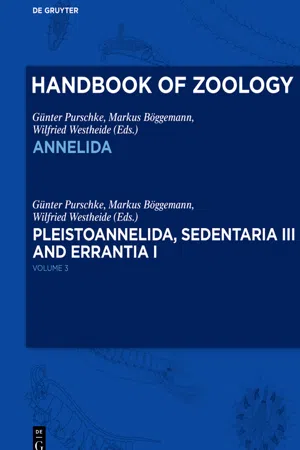
Pleistoannelida, Sedentaria III and Errantia I
- 491 pages
- English
- PDF
- Available on iOS & Android
Pleistoannelida, Sedentaria III and Errantia I
About this book
This book is the third volume in a series of 4 volumes in the Handbook of Zoology series treating morphology, anatomy, reproduction, development, ecology, phylogeny, systematics and taxonomy of polychaetous Annelida.
It is devoted to the remaining Sedentaria and the first branches of Errantia. These sedentary polychaetes are Terebellida and Arenicolida, all of which are tube-dwelling and deposit feeders. The tubes may be simple burrows stabilized by mucus or the tubes are highly sophisticated often really aesthetic structures build-up of sediment grains glued together by their secretion. Although the former possess anterior appendages used for collecting food particles, these are likely not modified palps rather than a new acquisition. Many of these species are adapted to occur within environments characterized by low oxygen supply and so many members of these taxa possess elaborated branchiae, usually positioned on a number of anterior body segments except for Maldanidae which look like bamboo sticks and thus earned their common name bamboo worms. Members of Arenicolida and Maldanida may occur in high abundance and as such they create biogenically graded sediment beds.
The Errantia part starts with Myzostomida, a group of symbiotic animals associated with echinoderms which have been variously placed within the tree of life. As such they show numerous adaptations to this specific mode of life. The next group discussed within Errantia is Protodrilida, a taxon comprising four families of the former archiannelids which belong to the interstitial fauna. Most likely they evolved by miniaturization from larger ancestors. In contrast to typical errants they do not possess well-developed parapodia and antennae. This taxon is followed by Eunicida characterized by possession of a specific jaw apparatus situated ventrally in the foregut and associated with specific musculature. Also being a species rich group showing various feeding modes some of the smallest and the largest members belong to this taxon.
Frequently asked questions
- Essential is ideal for learners and professionals who enjoy exploring a wide range of subjects. Access the Essential Library with 800,000+ trusted titles and best-sellers across business, personal growth, and the humanities. Includes unlimited reading time and Standard Read Aloud voice.
- Complete: Perfect for advanced learners and researchers needing full, unrestricted access. Unlock 1.4M+ books across hundreds of subjects, including academic and specialized titles. The Complete Plan also includes advanced features like Premium Read Aloud and Research Assistant.
Please note we cannot support devices running on iOS 13 and Android 7 or earlier. Learn more about using the app.
Information
Table of contents
- Foreword
- Contents
- List of contributing authors
- 7. Pleistoannelida
- 7.4 Sedentaria: Spionida/Sabellida
- 7.4.8 Fabriciidae Rioja, 1923
- 7.7 Sedentaria: Terebellida/ Arenicolida
- 7.7.1 Pectinariidae Quatrefages, 1866
- 7.7.2 Ampharetidae Malmgren, 1866
- 7.7.3 Terebellidae s.l.: Polycirridae Malmgren, 1866, Terebellidae Johnston, 1846, Thelepodidae Hessle, 1917, Trichobranchidae Malmgren, 1866, and Telothelepodidae Nogueira, Fitzhugh & Hutchings, 2013
- 7.7.4 Alvinellidae Desbruyères & Laubier, 1986
- 7.7.5 Arenicolidae Johnston, 1835
- 7.7.6 Maldanidae Malmgren, 1867
- 7.8 Sedentaria incertae sedis: Diurodrilidae Kristensen & Niilonen, 1982
- Errantia
- 7.9 Errantia incertae sedis: Nerillidae Levinsen, 1883
- 7.10 Myzostomida
- 7.11 Errantia: Protodriliformia
- 7.11.1 Polygordiidae Czerniavsky, 1881
- 7.11.2 Saccocirridae Czerniavsky, 1881
- 7.11.3 Protodrilidae Hatschek, 1888
- 7.11.4 Protodriloididae Purschke & Jouin, 1988
- 7.12 Errantia: Eunicida
- 7.12.1 Eunicida Dales, 1962
- 7.12.2 Dorvilleidae Chamberlin, 1919
- 7.12.3 Onuphidae Kinberg, 1865
- 7.12.4 Eunicidae
- 7.12.5 Histriobdellidae Claus & Moquin-Tandon, 1884
- Index